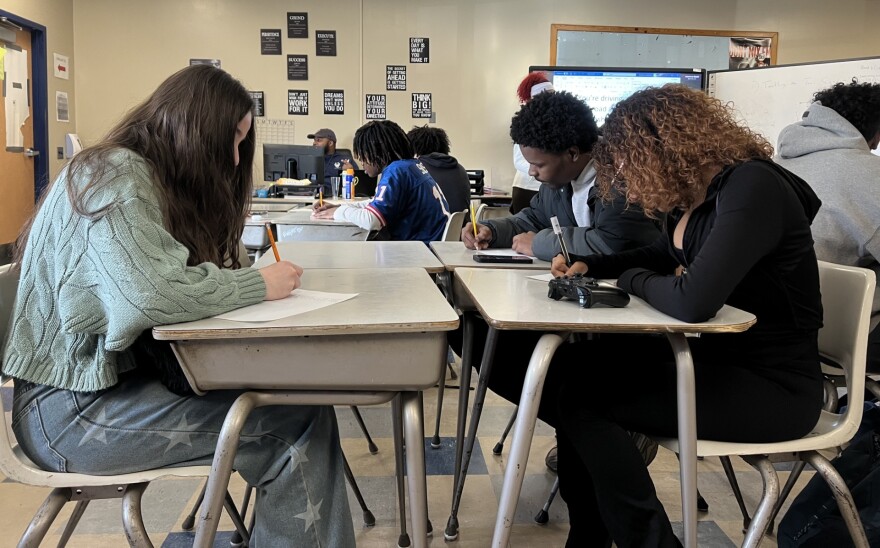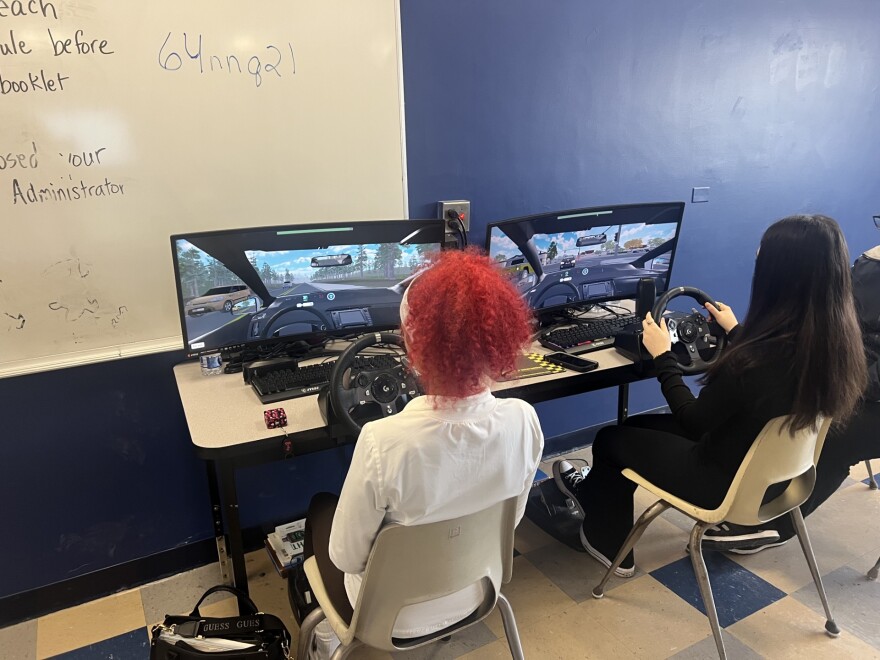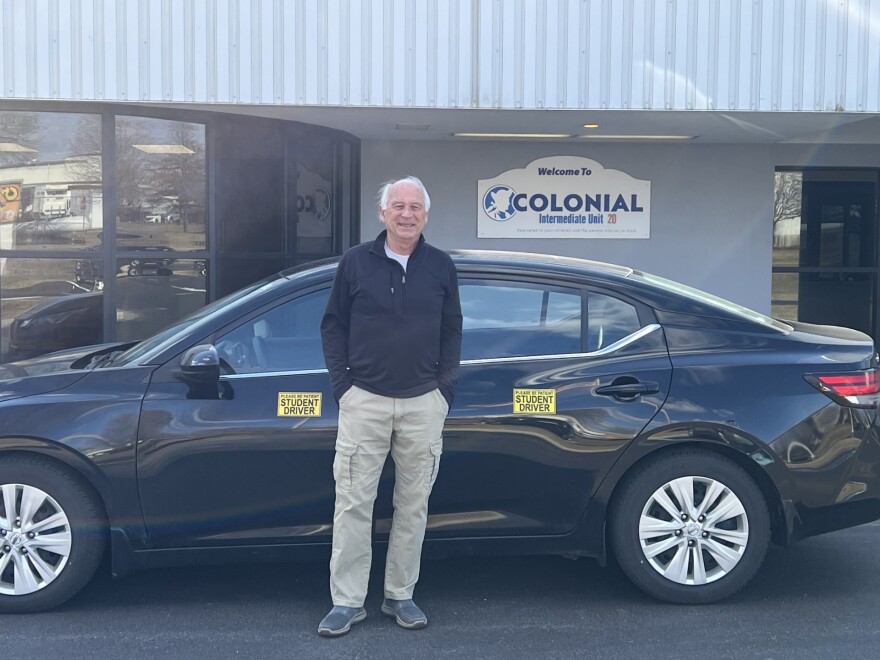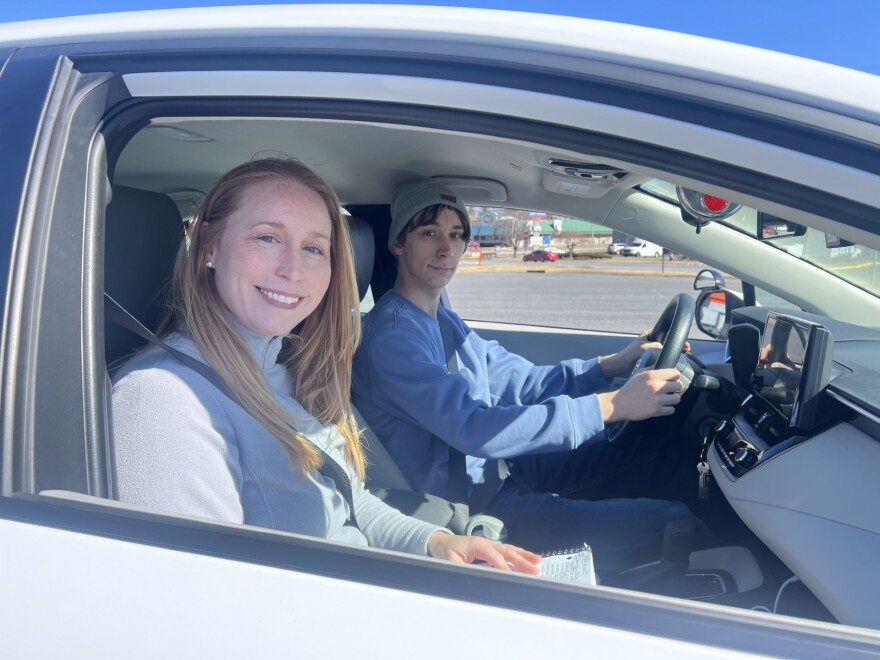The Road Ahead is a project by LehighValleyNews.com on traffic and transportation issues in Lehigh and Northampton counties. This is PART FOUR of the series.
ALLENTOWN, Pa. — As she hones her driving skills, 17-year-old Martina Ferriolo practices stopping for pedestrians, scanning the roadsides for deer and keeping with the flow of speedy highway traffic.
She does all of this and more from the comfort of her Dieruff High School classroom without ever starting an ignition.
Ferriolo and her classmates use a driving simulation that allows them to get a realistic feel for being on the road. The set-up comes with a steering wheel and pedals that let students manipulate their virtual vehicle on a computer screen.
“It gives you the experience to see that you really have to be fully attentive when driving [and] be aware of your surroundings,” said Ferriolo, a Dieruff senior.
The Allentown high school has five simulators for its driver education class, which is a theory-based elective that prepares students for their learner’s permit test.
“It at least makes them aware of different things they need to focus on when they’re in a real car."Jerome Ambrose, Dieruff High School driver education teacher
“It at least makes them aware of different things they need to focus on when they’re in a real car,” said Jerome Ambrose, Dieruff’s driver education teacher.
Allentown School District is one of just five Lehigh Valley districts that offer a driving theory or traffic safety class for high school students, despite the potential benefits and the heightened risk that teen drivers face. The other districts are East Penn, Parkland, Southern Lehigh and Wilson Area.
Driver education cuts
In addition to classroom instruction, East Penn and Southern Lehigh offer on-the-road training for high school students with the opportunity for licensure. They’re the only Lehigh Valley districts that do so. At East Penn, the training costs $250; at Southern Lehigh it's free.
Meanwhile, the remaining 12 school districts in Lehigh and Northampton counties offer no driver education of any kind in their schools. Instead, they refer students and families to classes and hands-on training offered through local intermediate units, or private driving schools approved by the state Department of Education — of which there are nine in the Lehigh Valley.
But driver education programs used to be widespread in public high schools across the United States, having emerged from a national driver safety movement in the 1930s due to the recent ubiquity of cars.
Then, over the years, the course began disappearing as school districts faced difficulties balancing their budgets and looked for savings opportunities among non-essential programming.
In the Lehigh Valley, some districts similarly ended or pared down their driver education programs throughout the 1990s, 2000s and 2010s as a way to cut costs. For instance, Bethlehem Area saved $72,500 by nixing its program in 2009 amid uncertain funding from Harrisburg.

Driver education benefits
But as for the local programs that remain, educators and students say they benefit teens by preparing them to be safe drivers.
“It’s obviously nicer in our setting just because we can spend a little bit more time and talk about [different scenarios],” said Jake Beitler, a driver education teacher and on-the-road instructor at Emmaus High School.
It’s these discussions that prepare teens to make split-second decisions once they get behind the wheel alone.
Stephen Ott, the driver education teacher at Parkland, said he tells his students about how to respond to potential hazards, such as being tailgated by another driver or approaching a vehicle with its high beams on.
He also emphasizes the importance of avoiding distractions, such as cell phones, and going the speed limit, he said.
Parkland requires 10th graders to take the semester-long traffic safety class.
“I’m glad [we] have this program because it helps increase safety in the community, and that’s very important."Stephen Ott, Parkland High School traffic safety teacher
That’s the grade when most students turn 16 and become eligible to take their learner’s permit test. Once they pass, they can begin driving under supervision, according to Pennsylvania law. The state requires 65 hours of driving throughout the span of six months for students under 18 before they can then test for their junior license.
“I’m glad [we] have this program because it helps increase safety in the community, and that’s very important,” Ott said.
East Penn and Southern Lehigh also require students to take their respective driver education classes in order to graduate. Additionally, both districts offer on-the-road training, but it’s optional.
“The hope is that through theory courses you’re going to reduce the amount of accidents and also reduce the amount of fatalities,” Ott said.
Teens face risks on the road
And Ott’s safety focus is well-founded.
Teens are the riskiest drivers on the road, and crash-related injuries are a leading cause of death for young people.
That’s according to the Insurance Institute for Highway Safety’s analysis of 2016-17 data from the National Household Travel Survey and 2022 data from the National Center for Injury Prevention and Control — both the most recent data available.
Teens ages 16 to 19 crash at a rate four times that of drivers 20 and older, according to the IIHS’s analysis of travel survey data. The fatal crash rate per mile driven for 16- and 17-year-olds is about three times the rate for drivers 20 and older.
Nationally, 2,883 teens died from crash-related injuries in 2022, according to the IIHS’s analysis of injury center data.
Rebecca Weast, a senior IIHS research scientist, said teens are overrepresented in fatal crashes that can be attributed to driver error and excessive speeds. She said teens are also more likely to crash at nighttime or when they have passengers in the car. Teen drivers are also disproportionately involved in single-vehicle crashes.
In Lehigh and Northampton counties, state police recorded 161 crashes involving teen drivers ages 16 to 18 in 2024. Of those crashes, 50 were attributed to driving too fast for road conditions — the top crash cause among the data. Other top causes included improper or careless turning and careless passing or lane change.

Weast said teen drivers are not a monolith and the causes for their high crash rates tend to be oversimplified. But some possible reasons include a lack of maturity and experience, she said.
“Teenagers have to think about everything that they’re doing,” Weast said. “A lot of those skills have not yet become automatic, so they have to learn how to weigh relevant information from irrelevant information.”
For instance, teens are assessing when to accelerate, when to brake and how hard to push down on each pedal, she added.
Worth incentivizing
These are some of the skills local teachers said they discuss with teens through driver education.
But Weast said there’s no definitive data on the impact of driver education. That’s because driver education varies so much throughout the country, that it’s “almost impossible” to do a well-controlled study comparing teens who participate and those who don’t.
Weast doesn’t want to write off driver education altogether though.
“It’s certainly not harmful,” she said.
Weast said there’s “a reasonable amount of data” that teens report feeling more prepared having completed a driver education program, and their parents feel more comfortable having them on the road.
“I look at that and know that it doesn’t hurt and [see] there’s a chance that it helps. ... We should incentivize it.”Rebecca Weast, a senior research scientist at the Insurance Institute for Highway Safety
“I look at that and know that it doesn’t hurt and [see] there’s a chance that it helps,” Weast said. “We should incentivize it.”
That’s the goal of state Rep. Anthony Bellmon, D-Philadelphia. He and fellow Philadelphia legislators are drafting a memo to create a state driver education grant program, following a similar failed effort in 2023.
Currently, Pennsylvania school districts receive a $35 per student reimbursement for their driver education programs.
Bellmon said a grant program would be more effective at helping school districts afford upfront costs for teachers, vehicles and other necessary supplies.
It’s still early in the legislative process, but Bellmon is hoping to find Republican co-sponsors for the memo. Driver education is important to students in both urban and rural communities, he said.
“Driver’s education classes or programs at school provide a lot of necessary benefits,” Bellmon said. “Besides it just being a way for young people to be independent, it’s also a way for them to have access to opportunities for jobs in the future.”
Bellmon hopes a grant program would incentivize public schools to offer driver education again.

Intermediate units step in
In the meantime, Lehigh Valley students without access to such programs in their schools have a few options for driver education.
The Carbon Lehigh Intermediate Unit 21 offers a driving theory course and behind-the-wheel instruction to students whose school district has an agreement with the CLIU 21. The agreement does not cost districts anything. Program costs fall to parents who want their child to participate.
Currently, eight Lehigh Valley school districts have a driving education agreement with CLIU 21, including Catasauqua Area, Northampton Area, Parkland, Salisbury Township, Southern Lehigh, Northern Lehigh, Northwestern Lehigh and Whitehall-Coplay.
The intermediate unit offers six hours of on-the-road training for $325; during the last session, students can opt to take their licensure test with a certified instructor.
“It gives you a consistent curriculum,” said Randy Parry, CLIU 21 director of transportation services. “It looks at key things that all drivers should know about — speeding, proper distance between vehicles, make sure you’re looking ahead, anticipate problems, all of that stuff.”
The CLIU 21 also offers a 30-hour driving theory course online for $118; it’s open to students whose home district does not have such a course.
The Colonial Intermediate Unit 20 also offers six hours of on-the-road training; its fee is $375, and students can take their driver’s license test during the last session, too. But in order to take the test, students must have previously taken a driving theory course.
The CIU 20 does not currently offer a theory course, but is finalizing an online one to launch in the fall, according to officials.
All Northampton County member school districts are able to participate in the CIU 20 driver education training.
Private driving school options, benefits
Lehigh Valley parents can also opt to take their students to a private driving school, such as Callahan Driving School and Testing Center in Bethlehem, which offers an online theory course, on-the-road instruction and a licensure testing option.
Bryan Callahan, founder and owner of the driving school, said one benefit to on-the-road training is a car insurance discount.
Most insurance companies offer an annual $200 to $250 discount on plans that cover young people ages 16 to 21 if they’ve had six hours of on-the-road instruction, Callahan said. Some also require the completion of a 30-hour theory course.
At Callahan’s driving school, six hours of lessons and a road test costs $588, he said. When considering the five years of discounts, families end up saving money by paying for the training, he said.
Callahan said another benefit to programs like his is that instructors are trained on how to teach driving in a digestible way.
“Parents know how to drive, but they don’t know how to explain it,” he said.

Laurie Cybuck, co-owner of Walter’s Driving School, agrees.
“They’re more likely to listen to us than their parents,” she said. “It’s hard to break it down into pieces and give tips to your kids.
“We have a lot of little tricks and things that we find are really helpful to the student.”
Walter’s Driving School offers tailored instruction based on student needs, Cybuck added. Each lesson is 90 minutes and costs $130. Students and families can select how many lessons they want. Walter’s does not provide testing.
Cybuck recommends parents bring their teens to work with a driving instructor as soon as possible after getting their permit.
“Sometimes people come to us later in the process and then they have some bad habits,” Cybuck said.
Those may include palming the steering wheel, rolling stops or going over the speed limit.
“It’s very difficult to fix them because they’ve been doing that for almost six months,” she said.
Teens hesitant, anxious to drive
But some teens aren’t even interested in getting their permit. They’re too anxious, teachers said — a trend they’ve noticed after the COVID-19 pandemic.
“I have a lot of students, even seniors, that just are [too] timid to even start driving."Mike Falcone, Wilson Area High School's traffic safety teacher
“I have a lot of students, even seniors, that just are [too] timid to even start driving,” said Mike Falcone, the traffic safety teacher at Wilson Area High School. “They [talk] about maybe having a little anxiety driving or not wanting to try again.”
Experts agree the COVID-19 pandemic impacted teens’ mental health, increasing anxiety for some. But whether this anxiety has influenced students’ willingness to drive remains to be seen. Weast, of the Insurance Institute for Highway Safety, said it’s too soon for a body of research to exist around this topic.
Still, the percentage of teens 19 and under with a driver’s license declined from 41.5% in 2018 to 33.4% in 2023 — a drop of about 8%. That’s according to data from the Federal Highway Administration.
Marlon Randall, dean of students at Dieruff and the former driver education teacher, said he noticed some students were fearful about driving in the years after the pandemic.
“Even when they get on the simulators, they’re anxious. They get upset,” he said. “Then they give up. The level of confidence is so low and they’ll give up and they won’t drive.”
Randall said some teens aren’t in a rush to get their license because they’re comfortable waiting for a parent to pick them up or paying for an Uber or Lyft ride.
“To them, they don’t see a need,” he said.
That wasn’t the case with his generation, Randall said.
“We wanted that freedom,” he added. “We wanted to hurry up and get the license, so we could borrow mom’s and dad’s car and get the heck on out and go have fun.
“I don’t think the fun and love of learning how to drive is the same.”
MORE: Check out all of the content from The Road Ahead project, and register to join our live, studio audience on Thursday, April 3, for "A Community Conversation: The Road Ahead," at the Univest Public Media Center in Bethlehem on PBS39.


